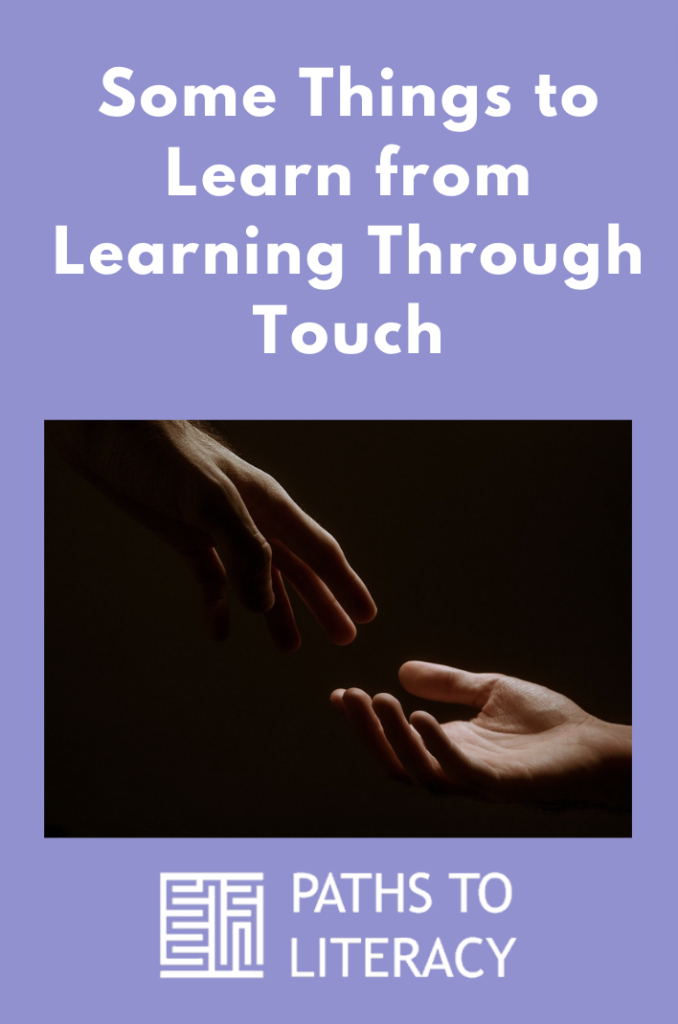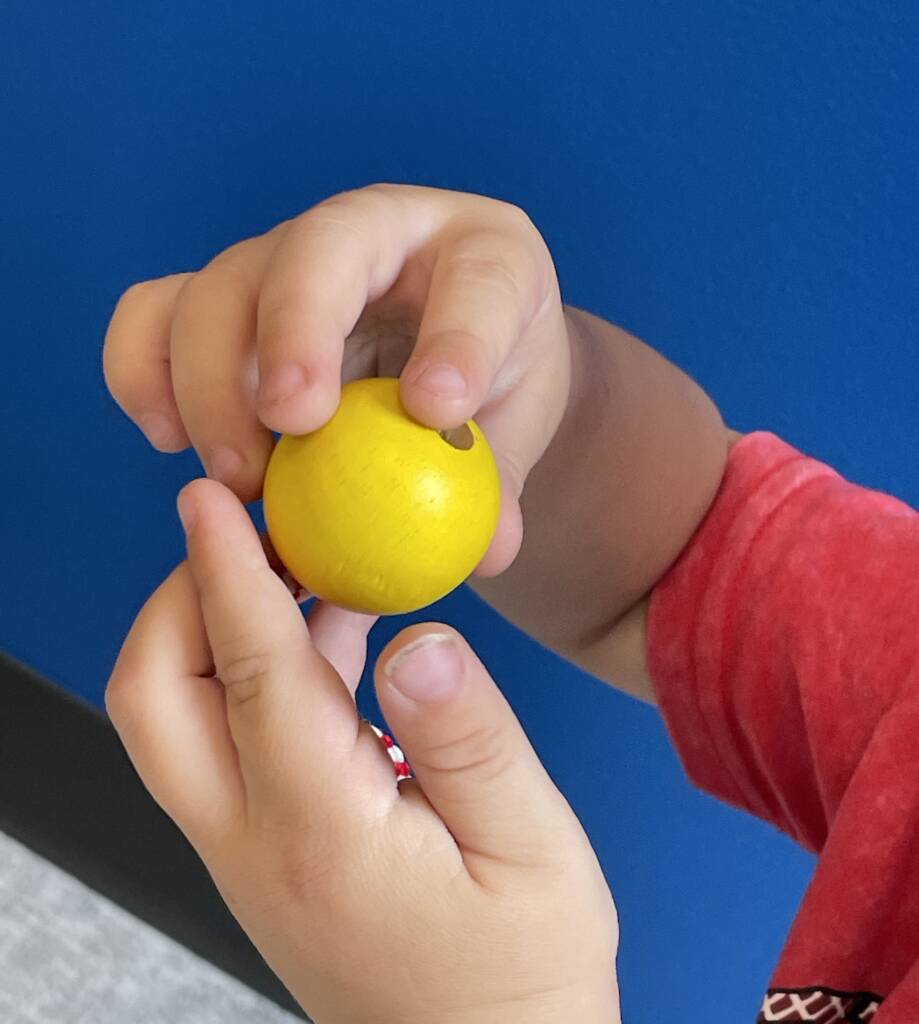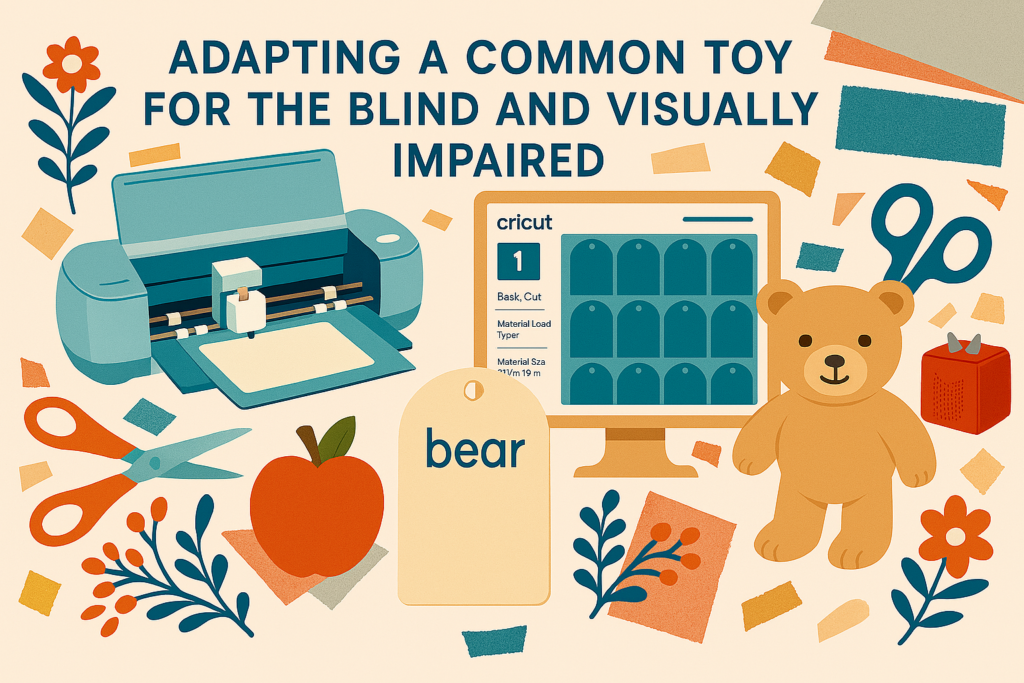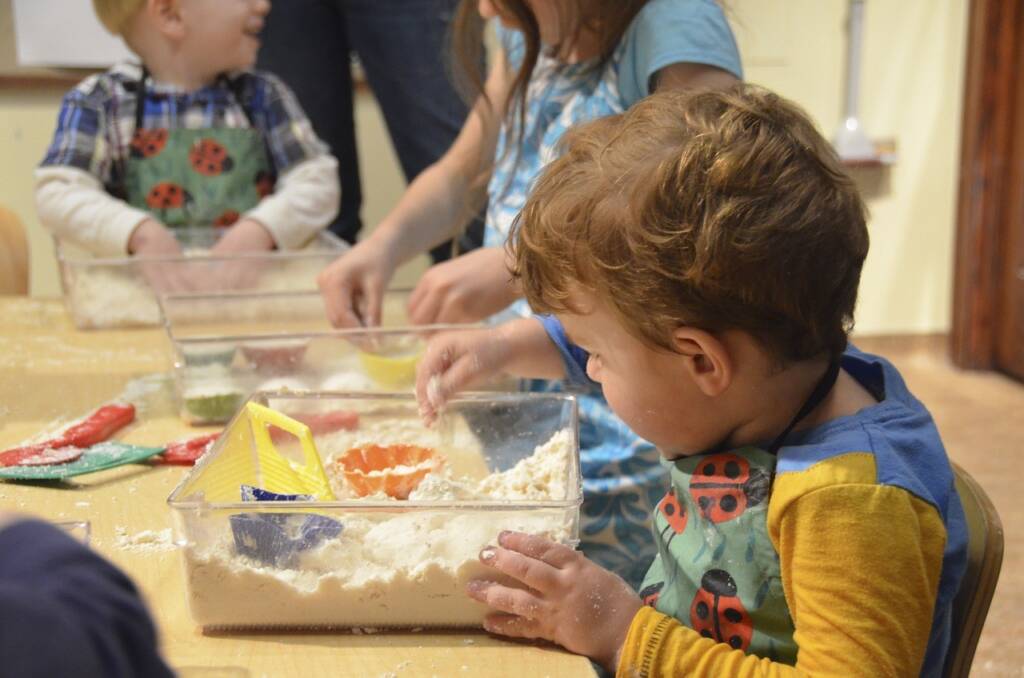It stands to reason that children who are visually impaired or deafblind would be more reliant on touch or their tactile sense to experience the world. These children have different needs and different skills related to their use of touch in learning. Unfortunately, many of us don’t know all that much about how to help these children develop better tactile skills and make better use of their tactual sense.
The work of such people as Barbara Miles, Lilli Nielsen, and Deborah Chen has made us very aware of the need to pay more attention to this sense in programming for these children. We are beginning to use hand-under-hand in our interactions with these children, and becoming more mindful of what message our touch conveys. We are providing them with a greater variety of textures and materials and giving them more time and opportunities for independent exploration of these objects. We are recognizing that hand use progresses systematically simply by the child completing constant repetition of specific hand movement schemes. We are thinking about touch as it relates to literacy and general learning. In short, we are becoming better educated about the importance of developing touch in all our children with visual impairments and deafblindness.
Recently a colleague shared a copy of a book, Learning Through Touch, by Mike McLinden and Steve McCall from the School of Education at the University of Birmingham in the United Kingdom. This book includes information on the anatomy and physiology of touch, the functions of touch, assessing touch, and providing instruction through touch. I was struck by a number of things I read and want to encourage our readers to try to find a copy of this book. The book may be ordered through Routledge Publishers.
The Anatomy and Physiology of Touch
Our largest organ is our skin. It serves a number of purposes, such as protecting our internal organs from infections, and is also the location of the tactile receptors in our body.
The skin has an outer layer called the epidermis and an inner layer called the dermis. In each of these layers of skin are different tactile receptors or nerve endings, which seem to respond best to particular types of stimuli. These receptors are generally divided into three categories:
- Mechanoreceptors: respond to indentations of the skin. An example of this is when a finger presses against the back of the hand. There are two types of these mechanoreceptors: those that are rapidly adapting and those that are slowly adapting.
- Thermoreceptors: respond to temperature changes.
- Nioceptors: respond to stimuli that damage the skin such as intense heat or the prick of a pin.
Even though each of these receptors responds best to these stimuli, they also respond to some degree to all types of tactual stimuli.
Tactile receptors are also located in the joints, tendons and muscles, and limbs. These help form part of the proprioceptive system. The proprioceptive system allows us to know about the stationary position of our body and also give us information about our movements. We know where our hand is and how to make it move out to reach and grasp an object because of our proprioceptive system. The visual system ties into the proprioceptive system, too, which is why some children with visual impairments have problems knowing where their bodies are located in space.
The sensations coming to us from outside our body and those coming from inside our body are experienced as two separate sensations that our brains are able to process so we can complete a wide variety of actions. When we manipulate a small object such as a pen with our hands behind our backs we know where our hands are in relation to one another, even if they do not touch. We experience the feel of the pen and can explore it, turn it, and transfer it without looking all because of the tactile sensations we experience within our bodies and from outside our bodies.
Tactile information is sent to the brain from the receptors along two main neural pathways. One pathway, called the dorsal column medial lemniscal system (DCMLS), can be thought of as a discriminatory system. It carries information we obtain through active exploration and includes such information as pressure, vibration, and proprioception. The other system, called the anterolateral system (ALS), carries information that helps our body defend itself by relaying information about pain and temperature. The DCMLS ends in the somatosensory cortex within the parietal lobe of the brain located at the top, back part of your head. The ALS appears to be a more primitive system and ends in the reticular formation that is located just above the area of the brain stem.
Although these systems are separate, they do have some overlap of function. For example, some pain information may be carried by the DCMLS, and some tactile discrimination information may be carried by the ALS. This might explain why some children avoid touching or being touched. If damage is done to one of these systems the result may be that the other system becomes more dominant. The ALS system, which handles pain, is less vulnerable to damage than the DCMLS system. Children who are tactually defensive may be responding to touch primarily through the ALS and experience its defensive function.
The Functions of Touch
The active use of touch to “seek out and acquire information” has been called “haptic touch.” The “haptic system” has been defined as a distinctive perceptual system, oriented towards discriminating and recognizing objects by handling them as opposed to looking at them. (McLinden & McCall, 2002) McLinden and McCall share information about the various property features we acquire through the haptic system. These include:
- Vibration/Surface texture
- Wetness/dryness
- Surface temperature
- Shape
- Slope
- Curved
- Hardness/softness
- Weight
- Elasticity
- Pliability
Many types of touch are active, but some types of touch are not active. For example, we can experience the breeze blowing on our faces and the warmth of the sun. We can feel vibrations from the car next to us that is playing music too loud.
Touch can be interactive or non-interactive. Interactive touch includes such actions as hugging, kissing, or shaking hands. Non-interactive touch includes things like resting your hands in your lap, massaging a leg cramp, or bathing.
Think about the difference in the kind of information you can receive through various types of touch. For example, if you simply place your hand on a cat without moving it, what could you learn about the cat? You would feel warmth from its body and, depending on where on the cat’s body your hand was placed, some information about how soft or hard it is. If the cat is purring, you might experience some of the vibrations it makes. Passive touch like this does not provide that much information about the cat. However, if you pet the cat and examine it from head to toe by exploring it with your hands and fingers, you would find out it has fur, a tail, legs, whiskers, eyes, and ears. You might have some idea of the weight, size, and shape of the cat and whether it has short or long hair. Through interactive touch you might also learn about teeth and claws!
Hands play a leading role in touch for most of us. Still it is important to remember that we also use other sensitive parts of our bodies in touching. This is especially important to remember when we are working with children who do not have good use of their hands. A great deal of information can be gained through exploration with lips and the tongue, with feet, and with other parts of our bodies. In fact, a baby first explores with his or her mouth, and often uses his or her feet to explore things as well.
As the child’s vision and motor skills develop, a typical baby begins to incorporate more and more strategies for exploring objects with the hands. Many of these strategies are learned through watching others, but also are developed naturally by just interacting with a million different things. Think about the ways most babies spend their time. They are constantly interacting with the objects in their world — reaching and grasping, banging and batting, putting together and taking apart.
When we think about children with blindness and deafblindness, we can begin to see how important it is to develop haptic ability (or hand use). Hand use and cognition are tied together. The more capable any child is in their exploration of objects with their hands, the better they are able to formulate concepts that are critical to learning. One researcher, Rochat, suggested that vision is the ‘organizer’ of different types of sensory information. As the child manipulates the object they view it from different perspectives and learn about its properties. So sight helps the baby make sense of what they are feeling. Stilwel and Cermak note in Hand Function in the Child: Foundation for Remediation (1995) in their chapter, “Perceptual functions of the hand” that young babies’ do not so much use sight as a substitute for touch but rather they use sight to guide their haptic manipulation, in order to make the sensory input more meaningful. (McLinden & McCall, 2002)
For children with visual impairments, vision may not help them make meaning from what they are experiencing. At the same time, touch may be all they have to work with to help them experience the world. When a visually impaired child’s sense of touch is also impaired because of motor problems, missing or malformed limbs, or because of prolonged restraining by IV lines and such, they are denied a great deal of information about how the world works. It is understandable that these children often show cognitive delays as well.
What Can We Do to Develop Hand Function?
If hand function is so important, what can we do to help our blind and deafblind children to develop these critical haptic skills? Although there is very little research-based guidance on what we should do, current best practice gives us some guidelines. These strategies include:
Honor the child’s hands. Do not grab or hold the child’s hands any more than is absolutely necessary. Build trust between you and the child so that he/she is inclined to trust you not to try to control what he/she does with his/her hands.
Watch what the child does with his/her hands. Barbara Miles reminds us this is especially important for the child who is deafblind since their hands may serve as eyes, ears, voice, and tools. When we look at what the child does with his/her hands, we can have a better understanding of what the child might know about the world.
Use a hand-under-hand approach in guiding the child or modeling actions with your hands. This also means offering objects to the child by bringing them up underneath his/her hand rather than taking the child’s hand to the object.
Watch what a child can do with his/her hands. This can be done through formal assessment and informal observation. There are a number of tools programs can use to assess the haptic sense and hand use in children with visual impairment and deafblindness. Some assessment tools that are used frequently in the United States include the Callier-Azusa Scale, Functional and Instruction Scheme, Home and School Inventories or Problem-Solving Skills, and the INSITE checklist.
Give the child objects that encourage the development of skills. For example, if you want the child to develop finger isolation, give him many different objects that encourage that skill, such as metal washers and nuts, wire whisks, loose knit fabric, rings or sections of tubing, containers with holes in them, and so forth. Expand skills horizontally (letting him practice this skill with many different objects) before trying to achieve higher-level skills.
Provide the child with many opportunities each day to explore a wide variety of objects on his/her own. These should have different textures, weights, temperatures, shapes, flexibility, and hardness. Most of the Active Learning theory focuses on this approach. If the child’s hand use is limited by other disabilities, we need to make sure that things come to his hands.
Make your hands available to the child for him/her to be able to tell you something or show you something. A nice way to do this is to simply hold your hands out to the child with the palms facing up. Let the child take your hand and guide it where he/she wants.
Model hand-use for the child as you do things. This is typically done using hand-under-hand approach as you complete everyday activities such as opening, closing, twisting, rubbing, reading Braille, signing and so forth. The child can learn a great deal about hands from “watching” what you do with your hands.
Let the child know you are experiencing the object he/she is experiencing. Co-actively touching objects that the child is touching is the equivalent of using a pointing gesture to reference an object that the child is looking at. This allows the child to share information with you about the object.
Play hand games with the child. Begin by imitating what the child does with his/her hands. As time goes on and the child begins to attend to what your hands are doing introduce new actions or movements. Clap, wiggle fingers, shake hands, rub them on a surface; any interaction the child is interested in will work.
Offer many hands-on learning experiences with real objects. Avoid the use of miniatures or replicas.
Provide more time for the child to explore objects within activities. What we can quickly take in with our vision requires more time to learn with our tactile sense.
Create object books and boxes for a child to “recall” an event they have experienced byexploring materials associated with that activity. For example, a trip to McDonald’s might be recalled by exploring a collection of objects such as a straw, a french fry cup, a toy surprise, and a sticky napkin.
Conclusion
Developing the sense of touch and good hand use skills are important goals for any child who is blind or deafblind. The tactile sense often is needed to confirm what the child is seeing or hearing. Using the sense of touch to teach children with visual impairment or deafblindness may be challenging to us as sighted and hearing individuals. We must think about the child’s experience of the world and find ways to enhance the use of the child’s tactile sense in all the activities we do.
There are many good resources to help us learn to make better use of a child’s tactile senses. Some of these are listed below. Learning Through Touch may not be a book that is familiar to many of us in the United States, but it is another great resource for teachers and parents alike who want to have a better understanding of the critical role touch plays in learning for children who are blind and deafblind.
References and Resources
References:
McLinden, M. and McCall, S. (2002). Learning Through Touch: Supporting children with visual impairment and additional difficulties. London: David Fulton Publishers, Ltd. The Chiswick Centre, 414 Chiswick High Road, London W4 5TF.
Stilwel, J.M. and Cermak, S.A. (1995). On the Way to Literacy: Early experiences for visually impaired children. Louisville, KY: American Printing for the Blind.
Rochat, P. (1989). “Object manipulation and exploration in 2- to 5-month-old infants”, Developmental Psychology 25, 871-4.
Resources:
Miles, B. (2003). Talking the Language of Hands to the Hands. Monmouth, OR: DB-Link.
Project SALUTE: Successful Adaptations for Learning to Use Touch Effectively.
This article was originally published in the Spring 2005 SEE/HEAR Newsletter by Texas School for the Blind and Visually Impaired (TSBVI) and is reprinted here with permission.





